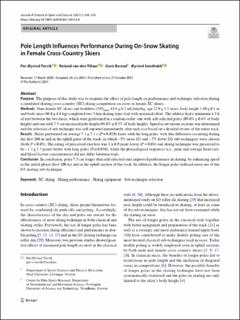| dc.contributor.author | van den Tillar, R. | |
| dc.contributor.author | Bostad, Guro | |
| dc.contributor.author | Sandbakk, Øyvind | |
| dc.date.accessioned | 2022-02-14T10:14:33Z | |
| dc.date.available | 2022-02-14T10:14:33Z | |
| dc.date.created | 2022-01-06T22:32:25Z | |
| dc.date.issued | 2020 | |
| dc.identifier.citation | Journal of Science in Sport and Exercise (SSEJ). 2020, 3 348-354. | en_US |
| dc.identifier.issn | 2096-6709 | |
| dc.identifier.uri | https://hdl.handle.net/11250/2978703 | |
| dc.description.abstract | The purpose of this study was to examine the effect of pole length on performance and technique selection during a simulated skating cross-country (XC) skiing competition on snow in female XC skiers.
Methods
Nine female XC skiers and biathletes (VO2max 63.6 ± 6.2 mL/min/kg, age 22.9 ± 3.5 years, body height 1.69 ± 0.1 m and body mass 60.8 ± 4.6 kg) completed two 5-km skating time-trail with maximal effort. The athletes had a minimum 4.5 h of rest between the two races, which were performed in a random order: one with self-selected poles (89.0% ± 0.6% of body height) and one with 7.5 cm increased pole length (94.0% ± 0.5% of body height). Speed in set terrain sections was determined and the selection of sub-technique was self-reported immediately after each race based on a detailed review of the entire track.
Results
Skiers performed on average 7.1 ± 7.1 s (P = 0.029) faster with the long poles, with this difference occurring during the first 200 m and in the uphill parts of the track, in which ~ 5% more G3 and ~ 5% fewer G2 sub-techniques were chosen (both P < 0.05). The rating of perceived exertion was 1 ± 0.9 point lower (P = 0.04) and skiing technique was perceived to be ~ 1.2 ± 1.5 points better with long poles (P = 0.038), while the physiological responses (i.e., peak and average heart rate, and blood lactate concentration) did not differ between trials.
Conclusion
In conclusion, poles 7.5 cm longer than self-selected ones improved performance in skating, by enhancing speed in the initial phase (first 200 m) and in the uphill section of the track. In addition, the longer poles induced more use of the G3 skating sub-technique. | en_US |
| dc.language.iso | eng | en_US |
| dc.publisher | Springer | en_US |
| dc.rights | Navngivelse 4.0 Internasjonal | * |
| dc.rights.uri | http://creativecommons.org/licenses/by/4.0/deed.no | * |
| dc.title | Pole Length Influences Performance During On-Snow Skating in Female Cross-Country Skiers. | en_US |
| dc.type | Peer reviewed | en_US |
| dc.type | Journal article | en_US |
| dc.description.version | publishedVersion | en_US |
| dc.source.pagenumber | 348-354 | en_US |
| dc.source.volume | 3 | en_US |
| dc.source.journal | Journal of Science in Sport and Exercise (SSEJ) | en_US |
| dc.identifier.doi | 10.1007/s42978-021-00134-0 | |
| dc.identifier.cristin | 1976236 | |
| cristin.ispublished | true | |
| cristin.fulltext | original | |
| cristin.fulltext | original | |
| cristin.qualitycode | 1 | |

